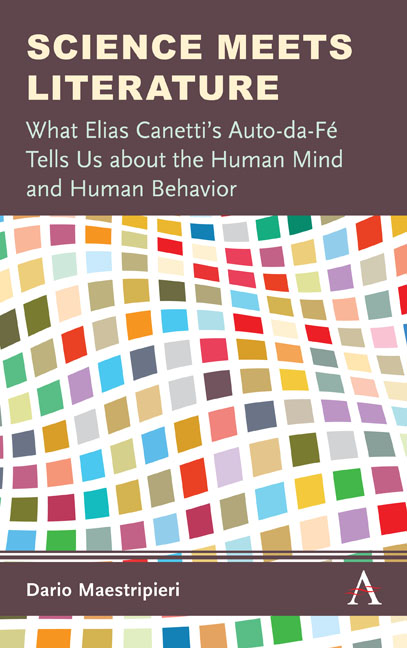 Science Meets Literature
Science Meets Literature Book contents
- Frontmatter
- Contents
- Preface
- Acknowledgments
- Chapter One Why Science and Literature?
- Chapter Two Elias Canetti: A Visionary Literary Genius on a Quest to Understand Human Nature
- Chapter Three The Plot of Auto-da-Fé
- Chapter Four Auto-da-Fé Is a Novel about Human Nature
- Chapter Five Major Themes Running Through Auto-da-Fé
- Chapter Six Analysis of Part I: A Head Without a World
- Chapter Seven Analysis of Part II: Headless World
- Chapter Eight Analysis of Part III: The World in the Head
- Chapter Nine Narrative Strategies in Auto-da-Fé
- Chapter Ten Consilience, the Canetti Way
- Elias Canetti: Chronology
- References
- Index
Chapter Two - Elias Canetti: A Visionary Literary Genius on a Quest to Understand Human Nature
Published online by Cambridge University Press: 06 July 2019
- Frontmatter
- Contents
- Preface
- Acknowledgments
- Chapter One Why Science and Literature?
- Chapter Two Elias Canetti: A Visionary Literary Genius on a Quest to Understand Human Nature
- Chapter Three The Plot of Auto-da-Fé
- Chapter Four Auto-da-Fé Is a Novel about Human Nature
- Chapter Five Major Themes Running Through Auto-da-Fé
- Chapter Six Analysis of Part I: A Head Without a World
- Chapter Seven Analysis of Part II: Headless World
- Chapter Eight Analysis of Part III: The World in the Head
- Chapter Nine Narrative Strategies in Auto-da-Fé
- Chapter Ten Consilience, the Canetti Way
- Elias Canetti: Chronology
- References
- Index
Summary
Elias Canetti was born on July 25, 1905, and died in 1994 at the age of 89. Everything Canetti wrote throughout his life, he wrote in German. All of his work has been translated into English (as well as many other languages), and I will mainly refer to the English translations, which were generally published a few years after the German originals. Canetti's extensive autobiography is crucial for understanding his life and his work. The first volume of his autobiography, The Tongue Set Free, covers the years 1905– 21. The second volume, The Torch in My Ear, covers the years 1921– 31. The third volume, The Play of the Eyes, covers the years 1931– 37. These three parts of his autobiography have been published together as a single 834-page volume called The Memoirs of Elias Canetti (first edition, 1999). The first three volumes of Canetti's autobiography are considered an outstanding literary achievement and played a significant role in his Nobel Prize for Literature in 1981. Although they only cover the first 32 years of Canetti's life, they provide an important window into his formative years and shed light on the early influences that shaped his thinking and writing. They are crucial for understanding the genesis of Auto-da-Fé, which was completed in 1931; the novel was the first major literary work written by Canetti as well as the only novel he ever wrote.
Elias Canetti was born in a small town in Bulgaria called, at that time, Ruschuk, now known as Ruse. The Canettis were Sephardic Jews: their ancestors had migrated to Spain after the Diaspora and had been forced to leave the country again at the end of the fifteenth century. Their last name was probably originally Canete, and was later Italianized as Canetti, even though the Canettis had nothing to do with Italy and never lived there. Many Sephardic Jews who left Spain moved to southern European and Middle Eastern countries. This was the case of Elias Canetti's close ancestors, who at some point settled down in Turkey. Elias Canetti's paternal grandfather relocated, along with his family, from Turkey to Bulgaria. Elias Canetti's mother was also a Sephardic Jew, and her family had similar roots as the paternal side of the family.
- Type
- Chapter
- Information
- Science Meets LiteratureWhat Elias Canetti's Auto-da-Fé Tells Us about the Human Mind and Human Behavior, pp. 11 - 18Publisher: Anthem PressPrint publication year: 2019


